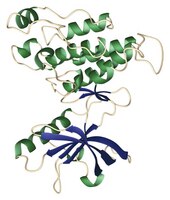Haloperidol regulates the phosphorylation level of the MEK-ERK-p90RSK signal pathway via protein phosphatase 2A in the rat frontal cortex.
Se Hyun Kim, Myoung Suk Seo, Won Je Jeon, Hyun-Sook Yu, Hong Geun Park, Gyung-Ah Jung, Hee Young Lee, Ung Gu Kang, Yong Sik Kim
The international journal of neuropsychopharmacology / official scientific journal of the Collegium Internationale Neuropsychopharmacologicum (CINP)
11
509-17
2008
概要を表示する
Haloperidol, a classical antipsychotic drug, affects the extracellular signal-regulated kinase (ERK) pathway in the brain. However, findings are inconsistent and the mechanism by which haloperidol regulates ERK is poorly understood. Therefore, we examined the ERK pathway and the related protein phosphatase 2A (PP2A) in detail after haloperidol administration. Haloperidol (0.5 and 1 mg/kg) induced biphasic changes in the phosphorylation level of mitogen-activated protein kinase kinase (MEK), ERK, and p90 ribosomal S6 kinase (p90RSK) without changing Raf-1 phosphorylation. Fifteen minutes after haloperidol administration, MEK-ERK-p90RSK phosphorylation increased, whilst PP2A activity decreased. At 60 min, the reverse was observed and the binding of PP2A to MEK and ERK increased. Higher dosages of haloperidol (2 and 4 mg/kg), affected neither MEK-ERK-p90RSK phosphorylation nor PP2A activity. Accordingly, PP2A regulates acute dose- and time-dependent changes in MEK-ERK-p90RSK phosphorylation after haloperidol treatment. These findings suggest the involvement of a dephosphorylating mechanism in the acute action of haloperidol. | 18272021
 |
Raf kinase as a target for anticancer therapeutics.
Sridhar, Srikala S, et al.
Mol. Cancer Ther., 4: 677-85 (2005)
2005
概要を表示する
The Ras-Raf-MEK-ERK (ERK) pathway is a logical therapeutic target because it represents a common downstream pathway for several key growth factor tyrosine kinase receptors which are often mutated or overexpressed in human cancers. Although considered mainly growth-promoting, in certain contexts, this pathway also seems to be apoptosis-suppressing. Several novel agents targeting this pathway have now been developed and are in clinical trials. One of the most interesting new agents is BAY 43-9006. Although initially developed as a Raf kinase inhibitor, it can also target several other important tyrosine kinases including VEGFR-2, Flt-3, and c-Kit, which contributes to its antiproliferative and antiangiogenic properties. To date, encouraging results have been seen with BAY 43-9006, particularly in renal cell cancers which are highly vascular tumors. This review will provide an overview of the ERK signaling pathway in normal and neoplastic tissue, with a specific focus on novel therapies targeting the ERK pathway at the level of Raf kinase. | 15827342
 |
Renewing the conspiracy theory debate: does Raf function alone to mediate Ras oncogenesis?
Repasky, Gretchen A, et al.
Trends Cell Biol., 14: 639-47 (2004)
2004
概要を表示する
Ras proteins function as signal transducers and are mutationally activated in many human cancers. In 1993, Raf was identified as a key downstream effector of Ras signaling, and it was believed then that the primary function of Ras was simply to facilitate Raf activation. However, the subsequent discovery of other proteins that are effectors of Ras function suggested that oncogenic activities of Ras are mediated by both Raf-dependent and Raf-independent signaling. Further complexity arose with the identification of Ras effectors with putative tumor suppressor, rather than oncogenic, functions. However, the recent identification of B-raf mutations in human cancers has renewed the debate regarding whether Raf activation alone promotes Ras-mediated oncogenesis. In this article, we summarize the current knowledge of the contribution of Ras effectors in Ras-mediated oncogenesis. | 15519853
 |
The RAF proteins take centre stage.
Wellbrock, Claudia, et al.
Nat. Rev. Mol. Cell Biol., 5: 875-85 (2004)
2004
概要を表示する
Since their discovery over 20 years ago, the RAF proteins have been intensely studied. For most of that time, the focus of the field has been the C-RAF isoform and its role as an effector of the RAS proteins. However, a report that implicates B-RAF in human cancer has highlighted the importance of all members of this protein kinase family and recent studies have uncovered intriguing new data relating to their complex regulation and biological functions. | 15520807
 |
Design and discovery of small molecules targeting raf-1 kinase.
Lowinger, Timothy B, et al.
Curr. Pharm. Des., 8: 2269-78 (2002)
2002
概要を表示する
Raf kinase, an enzyme which acts downstream in the Ras signaling pathway, is involved in cancerous cell proliferation. Thus, small molecule inhibitors of Raf kinase activity may be important agents for the treatment of cancer. A novel class of Raf-1 inhibitors was discovered, using a combination of medicinal and combinatorial chemistry approaches. This effort culminated in the identification of the clinical candidate BAY 43-9006, currently undergoing Phase I clinical trials. The present review summarizes the medicinal chemistry development of ureas as highly potent inhibitors of Raf-1 kinase. | 12369855
 |












